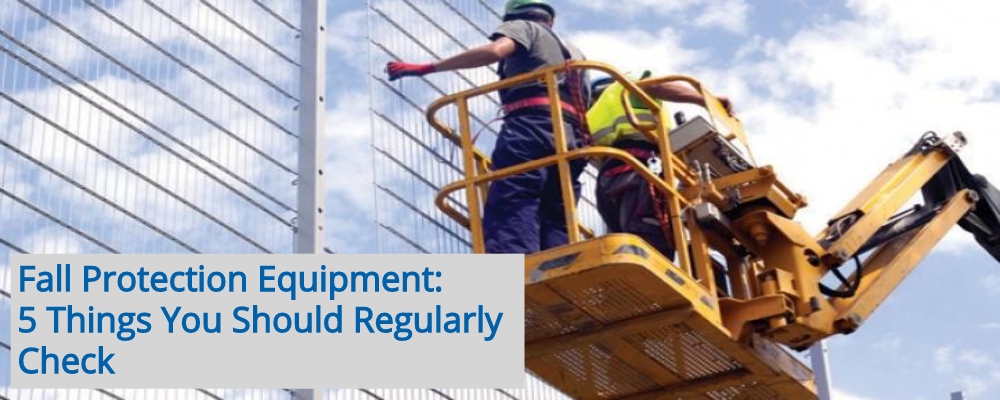5-Fall Protection Equipment Items to Regularly Check
01/07/2020
Category : Construction Safety

Growth of the construction industry means three things: more buildings, more jobs, and more fall protection equipment. In turn, an increased use of fall protection equipment will inevitably create more wear-and-tear. Component fractures, stressed cables, and deformities can all occur during typical day-to-day operations of any fall protection system or equipment.
Industry research from Dodge Data and Analytics indicates that new construction will hold steady at $776 billion, In 2020, institutional construction starts will essentially remain even with the 2019 level as the influence of public dollars adds stability to the outlook.
Your fall protection equipment must be routinely inspected, well-maintained, and repaired as needed. OSHA reports that, out of 4,779 worker fatalities in private industry in calendar year 2018, 1,008 or 21.1% were in construction — that is, one in five worker deaths last year were in construction. This means that properly functioning fall protection equipment could be the difference between life and death.
According to OSHA, Personal fall protection systems must be inspected before initial use during each work shift for mildew, wear, damage, and other deterioration, and defective components must be removed from service.
In addition, OSHA requires that fall protection be provided when working over dangerous equipment and machinery, regardless of the fall distance. Other means of fall protection that may be required on certain jobs include safety harness and line, safety nets, stair railings and hand rails. More information here: https://www.osha.gov/pls/oshaweb/owadisp.show_document?p_id=9720&p_table=STANDARDS
Here are the top five things to regularly check before you put your workers’ at-height, or where fall protection is required:
1. Fall Hazards
Before you set out to perform any job requiring fall protection equipment, you must first scan your environment for fall hazards. “A fall hazard is anything at your worksite that could cause you to lose your balance or lose bodily support and result in a fall,” according to OSHA. In the construction industry in particular, OSHA requires that fall protection equipment be provided for work completed at six or more feet from the ground.
Injuries and accidents from fall hazards can include the collapse of a makeshift scaffold that supports multiple workers, or a worker stepping into a skylight and falling through. The high risk that comes with work requiring fall protection, combined with OSHA's required Fall Protection Plan and hazard analysis, create the need for increased alertness and caution.
2. Lifeline Systems
Always inspect each component of your lifeline systems, including lanyards, harnesses, and rope grabs. Certain components of fall protection systems, such as lifelines, harnesses, and lanyards can be more likely to experience damage due to their daily wear-and-tear. OSHA requires that you consistently inspect for frayed edges, broken fibers, pulled stitches, and cuts on all of your fall protection equipment. Further, ensure that all buckle tongues are free of distortion and can move back and forth freely.
Due to the nature and intended use of these types of equipment, they are more likely to come in contact with materials that can compromise their integrity. For example, extreme heat causes nylon to become brittle, and rope lanyards can lose elasticity when exposed to chemicals. In fact, in 40% of all lifeline inspections, replacement is required.
3. Harnesses
One of the most important types of construction Personal Protective Equipment (PPE) is the harness. When inspecting harnesses, you should first gain knowledge of whether the equipment has been previously involved in a fall. OSHA mandates that harnesses involved in a fall may be determined suitable for use, however, industry standards imply that such a harness has served its purpose and should be discarded.

Harnesses may contain built-in fall arrest indicators, which make it easy to distinguish whether it is suitable for use during inspection. Other elements to check for before using a harness include belts and rings, D-rings, rivets, webbing, buckles, and bars and rollers. You can find specific information on the requirements for each and every piece of your fall protection equipment via OSHA here: https://www.osha.gov/laws-regs/regulations/standardnumber/1910/1910.140
4. Training
OSHA Regulation # 1926.503(a)(1) – The employer shall provide a training program for each employee who might be exposed to fall hazards. The program shall enable each employee to recognize the hazards of falling and shall train each employee in the procedures to be followed in order to minimize these hazards.
A training program is necessary to instruct employees how to perform their job tasks, as well as to explain the company-specific operating procedures. A written, thorough training program should be implemented before any work at heights is conducted.
The training program should address the OSHA standards for inspecting, maintaining, and replacing equipment. A good program will also detail the responsibilities of each crew member needed for a task, such as the Safety Monitor. Training programs should cover, in-depth, your organization's procedures for fall rescues. OSHA has provided an example of a fall protection training program to assist you in the development of your own plan – access the program here https://www.osha.gov/doc/residential_fall_protection/sample_fall_protection.html
5. Rescue Plan
OSHA 1926.502 (d)(20) officially states: “The employer shall provide for prompt rescue of employees in the event of a fall or shall assure that employees are able to rescue themselves.” When you whittle down this rule, the core of the meaning is that employers need to provide some form of rescue if a fall occurs.
Rescue planning is important because it helps make sure workers are operating within regulations, and can reduce the negative impacts of falls or noncompliance. Noncompliance can result in fines, increased insurance costs, worker injuries, and reduced employee morale and productivity after an incident.
OSHA 1926.502(k) mandates that each organization with employees who work at heights must develop a Fall Protection plan that is specific to their worksite. An up-to-date copy of the plan must be kept on the site.
Most jobs in the safety industry require a strong team of workers who will hold each other accountable to properly follow the active Rescue Plan and to get their jobs done as effectively and safely as possible. So, make sure that you and your crew are familiar with your organization's plan before performing work that requires fall protection.
Fallen Worker Rescue
An effective fallen worker rescue plan addresses the procedures, equipment, and personnel needed to ensure that a rescue proceeds quickly and efficiently when a fall occurs.
Even when a Personal Fall Arrest System (PFAS) works properly, the fallen worker is still in danger. The worker's body weight places pressure on the harness straps, which can compress the veins, and cause blood to pool, in the lower extremities and reduce blood return to the worker's heart. This condition is called suspension trauma, also known as harness hang syndrome. In medical terms, this results in orthostatic intolerance. If the pressure is not reduced promptly, the worker can lose consciousness within minutes. (See Suspension Trauma/Orthostatic Intolerance, OSHA Safety and Health Information Bulletin.
Self-rescue and aided rescue are two techniques for rescuing a suspended worker. Rescuing the worker promptly (i.e., aided rescue) or ensuring the worker can self-rescue is imperative to preventing injury or a fatality (see 29 CFR 1926.502(d)(20)) here: https://www.osha.gov/laws-regs/interlinking/standards/1926.502(d)(20)
Aided Rescue
A worker who is suspended from a lifeline and cannot perform a self-rescue will need help from trained rescuers using appropriate equipment, including appropriate fall protection. Off-site emergency response personnel may rescue suspended workers, although most 911 responders are not trained in how to do so.
Self-Rescue
With proper personal fall protection equipment, training and practice, a fallen worker can take steps to minimize suspension trauma. Self-rescue methods allow a fallen worker to temporarily relieve pressure on the legs or in some cases to even lower himself or herself to the lower level. Self-rescue methods are discussed in detail in Washington Industrial Safety & Health Division's Fall Protection Responding to Emergencies. For more information, see OSHA: https://www.osha.gov/dts/osta/otm/otm_v/otm_v_4.html#fallen
Think of your fall protection equipment inspection s a math equation:
Hazardous environments
+ daily wear-and-tear
= Necessary equipment inspection
Unfortunately, damage to your fall equipment is practically unavoidable due to the nature of the jobs for which it is required, and navigating how to maintain each piece is no easy feat. If your equipment is beyond repair, your local Safety Distributor can provide you with an array of fall protection products, advice and information on equipment inspection.

